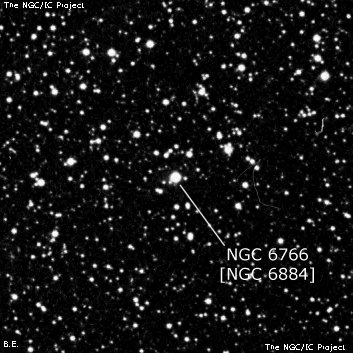
Ralph Copeland found NGC 6884 on 20 Sep 1884 at Dun Echt, Aberdeen, using an objective-prism sweep with a 6.1-inch refractor. He remarked "planetary nebula; most of the light in a single line" and measured a very accurate micrometric position (MN XLV).
Edward Pickering discovered this planetary earlier on 8 May 1883 using a direct-vision spectroscope (same technique) at Harvard College Observatory. Unfortunately, Pickering made a 1 hr error in RA (later corrected), so Dreyer catalogued it as NGC 6766 at the wrong position and this number is usually considered nonexistent. By historical precedence, this planetary should be called NGC 6766, but it is now known as NGC 6884.
Based on Crossley photographs at Lick, Heber Curtis (1918) noted "no central star can be distinguished. A minute, bright, round disk, of nearly equal brightness throughout, with a suggestion of an elongated brighter central portion in p.a. 135°; 7.5" in diameter in a 5 min exposure."
300/350mm - 13.1" (9/29/84): fairly bright, very small, high surface brightness, definite bluish disk at 166x, excellent contrast gain with OIII filter. Easily takes 350x due to surface brightness.
400/500mm - 17.5" (9/7/91): bright, very small, very high surface brightness. Appears as a slightly out of focus mag 11 bluish star at 100x. Moderate contrast gain using an OIII filter. At 412x appears prominent with a very small 5" blue disk.
Notes by Steve Gottlieb